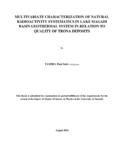| dc.description.abstract | The Magadi endorheic basin of Kenya, with its high heat flows due to magmatic activity, extremely saline geothermal manifestations, and vast deposits of trona, presents a complex closed ecosystem that is challenging to characterize and model. The Magadi basin is located in the southern part of the Kenya Rift Valley; an arid volcano-active continental rift that is part of the East African Rift Valley system. The area is bound by longitudes 36o 00’E and 36o 30’E and latitudes 1o 40’S and 2o 10’S. Lake Magadi lies to the south of the basin and is recharged mainly by highly alkaline geothermal springs around it. Being endorheic, the lake depends entirely on evaporation for hydrogeological balance. This, however, could make the lake a natural sink for radiopollutants from the surrounding geological, geothermal and anthropogenic activities.
We have measured activity concentrations and performed multivariate exploratory characterization of the radionuclides in relation to the modulating physico-chemical parameters of the Magadi basin. The main goal was to detect, measure and quantify as well as classify and relate the activity levels of 40K, 238U (226Ra), 232Th, and 210Pb, and to characterize their sources and distribution within the Magadi basin in relation to the quality of trona mined from the lake. This was realized via HPGe based gamma-ray spectrometry of trachyte rock, thermal water, sediments and raw trona from the basin as well as of processed soda ash and cattle salt from the Magadi Soda Company. The radionuclide activity concentrations and gamma spectra of the samples were analyzed using PCA, HCA and CT chemometric tools in order to classify, extract latent patterns, and model the radionuclide levels with respect to the sampling sites and spring T0, pH, s.g., TDS, TOC, Na2CO3, NaHCO3 and NaCl levels.
The mean activity concentrations of K-40, U-238 and Th-232 radionuclides in Bq/Kg were 1614±14.0, 162.3±13.5 and 120.1±15.1 respectively in rocks, 1875.8±10.8, 131.2±9.9 and 188.2±5.6 respectively in sediments and 127.6±21.7, 41.7±22.3 and 55.9±17.8 respectively in thermal water samples. K-40 and Th-232 were found to be accumulating within the Magadi basin with enrichment coefficients of 1.2 and 1.6 respectively. These levels are not as significant as would be expected for such a sink with constant contribution from the geothermal springs and weathering of surrounding volcanics in addition to both wet and dry atmospheric deposition; showing that the spring recharges have low-level radioactivity. Temperatures above 80 0C were observed to enhance thorium sorption capacity in sediments. Three regimes of alkaline spring inflows were found to contribute to and affect the quality of trona deposits in the lake and were delineated based on their radionuclide activity concentrations, feature selected gamma spectral signatures and solute content. These are: Na2CO3- and NaCl- rich inflows from the south; NaHCO3- rich inflows from the north; and saline fluid inflows from the host bedrock bounding the western edges of the lake.
Statistical analysis showed log normal distribution of the radionuclides within the basin, probably due to different radionuclide signatures of the spring recharges. PCA, HCA, CT and statistical analysis of the radionuclide levels and distributions in relation to thermal water temperatures, pH, TDS, TOC, and sediment CEC revealed marked diversity in the geochemical properties of the source rocks responsible for the spring solutes, and the presence of an underlying uranium-rich rock source. The Magadi basin is a sink for radiopollutants and a quasi HBRA. | en_US |

